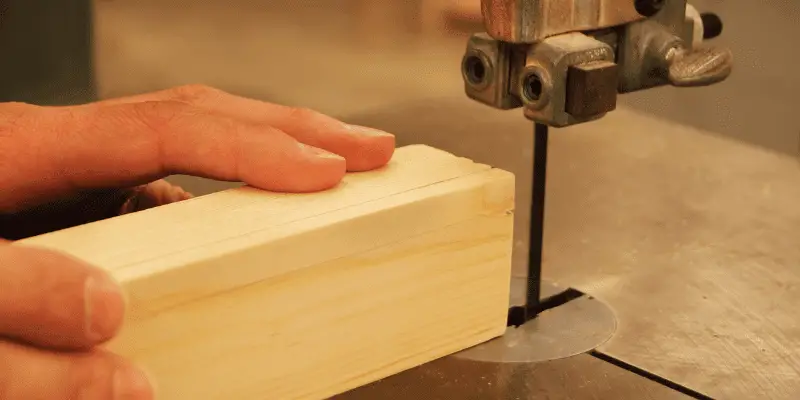Band saws are best for curved cuts and resawing, while table saws excel at straight cuts and ripping lumber. Both tools have their own strengths and choosing the right one depends on the specific woodworking needs you have.
Band saws offer greater versatility for curved and irregular cuts, making them suitable for intricate woodworking projects. On the other hand, table saws provide precise, straight cuts essential for large-scale projects and professional woodworking. Understanding the differences between these two saws can help you make an informed decision when selecting the appropriate tool for your woodworking tasks.
Let’s delve into a closer comparison of band saws and table saws to understand their respective features, applications, and benefits.
Understanding Band Saws And Table Saws
When it comes to woodworking, having the right tools is essential for creating precise and high-quality cuts. Band saws and table saws are two common tools used in woodworking, each with its own unique features and advantages. Understanding the differences between band saws and table saws is crucial for woodworkers to choose the right tool for their specific projects.
Definition And Purpose
A band saw is a power tool consisting of a continuous band of toothed metal, stretched between two or more wheels, used to cut material. It is commonly used for woodworking, metalworking, and cutting a variety of materials.
On the other hand, a table saw is a versatile woodworking tool with a flat table-like surface and a circular saw blade protruding from the center of the table, used for making straight cuts in wood and other materials.
Key Differences
The key differences between band saws and table saws lie in their cutting capabilities and versatility. While a band saw excels in making intricate curved cuts and is ideal for resawing and ripping, a table saw is best suited for making straight and precise cuts, such as rip cuts and cross cuts.
One notable difference is that band saws can effectively cut thicker and irregularly shaped materials, while table saws are more suitable for handling large sheet goods and making repetitive cuts.
Pros And Cons
- Band Saw Pros:
- Great for curved cuts and intricate designs
- Effectively handles thicker and irregularly shaped materials
- Some models offer the ability to resaw lumber
- Band Saw Cons:
- Limited for straight and repetitive cuts
- Requires periodic blade maintenance
- Table Saw Pros:
- Ideal for straight and precise cuts
- Excellent for ripping large sheet goods
- Provides a stable cutting platform
- Table Saw Cons:
- Not suitable for intricate curved cuts
- Can be more challenging to control for beginners
Performance And Versatility
The choice between a band saw and a table saw often comes down to performance and versatility. While both tools are indispensable in a woodworker’s arsenal, they each excel in different areas. In this section, we will fully explore the performance and versatility of band saws and table saws, diving into precision and accuracy, types of cuts, and material suitability.
Precision And Accuracy
When it comes to precision and accuracy, table saws typically take the lead. Their rigid tables and perpendicular cutting action provide precise, straight cuts. This makes them ideal for tasks such as ripping boards to a consistent width or creating repeatable cuts. On the other hand, band saws allow for more intricate and curved cuts, giving woodworkers the ability to create intricate designs with ease.
Types Of Cuts
- Table saws are well-suited for making rip cuts, crosscuts, and miter cuts. Their straight blade allows for efficient and accurate cutting of large, straight-edged materials.
- Band saws, with their continuous loop of blade, excel in cutting irregular shapes and intricate curves. These versatile tools are perfect for intricate woodworking projects that require detailed cuts.
Material Suitability
Both band saws and table saws have their own material suitability strengths. Table saws are ideal for cutting large, solid wood boards and sheet materials due to their stable cutting platform. Band saws, on the other hand, shine when it comes to cutting thinner or irregular materials, and are often used for resawing lumber, slicing veneers, or cutting curves and shapes in thicker materials.
Safety And Maintenance
When it comes to woodworking, both band saws and table saws are essential tools. However, when it comes to safety and maintenance, they each have unique considerations. Understanding the safety features, operational risks, and maintenance guidelines for these power tools is crucial for any woodworker. Let’s delve into the safety and maintenance aspects of band saws and table saws.
Safety Features
Both band saws and table saws come equipped with various safety features to minimize the risk of accidents. It is important to familiarize yourself with these features before operating the equipment. Some key safety features to look for include:
- Blade guards to prevent accidental contact with the cutting blade
- Emergency stop buttons for immediate halting of the machine in case of an emergency
- Rip fence for guiding the workpiece and maintaining a safe distance from the blade
Operational Risks
While these tools offer the convenience of precise cutting, they also pose operational risks if not used with caution:
- High-speed rotating blades can cause severe injuries if proper safety precautions are not followed
- Kickback is a common risk with table saws, resulting in the workpiece being forcefully thrown back towards the operator
- Band saws require proper tension adjustment of the blade to prevent snapping during operation
Maintenance Guidelines
Regular maintenance is essential for keeping band saws and table saws in optimal condition. Here are some maintenance guidelines to follow:
- Keep the blades sharp for efficient cutting and to prevent kickbacks
- Regularly inspect and replace any damaged or worn-out parts
- Keep the work area clean and free from debris to prevent accidents and ensure accurate cuts
Cost And Space Considerations
When choosing between a band saw and a table saw for your woodworking projects, it’s essential to consider the cost and space considerations. Both tools have their advantages and limitations, especially when it comes to initial investment, space requirements, and long-term durability.
Initial Investment
The initial investment for a band saw is generally lower compared to a table saw. Band saws typically vary in price based on the size, power, and additional features. On the other hand, table saws tend to be more expensive due to their mechanical complexity and larger working surfaces.
Space Requirements
Band saws are generally more compact and require less space compared to table saws, making them suitable for small workshops or garages with limited space. Additionally, band saws are often designed to be more versatile and can be moved around more easily.
Table saws, conversely, require a larger footprint for operation, and their stationary nature may limit the flexibility of workshop layouts. It’s essential to consider the available space and woodworking needs when deciding between the two options.
Long-term Durability
In terms of long-term durability, both band saws and table saws can be reliable investments. However, it’s important to consider factors such as maintenance requirements, build quality, and the intended frequency of use when assessing their long-term durability. Both types of saws have models designed to withstand heavy usage and provide lasting performance.
This HTML content provides information about the Cost and Space Considerations of Band Saw Vs Table Saw. It includes various HTML elements such as paragraphs and headings, along with writing techniques to make the content SEO-friendly and engaging.

Choosing The Right Tool For Your Project
When it comes to woodworking, selecting the right power tool can greatly impact the success and efficiency of your projects. Band saws and table saws are two of the most versatile and commonly used power tools in woodworking. Each tool has its own unique characteristics, and choosing between them often depends on the specific project requirements, personal skill set, and future scope and flexibility.
Project-specific Usage
The choice between a band saw and a table saw largely depends on the nature of the project at hand. Band saws are ideal for making curved cuts, intricate designs, and resawing thick lumber. They excel at cutting irregular shapes and are a go-to tool for woodturners and furniture makers. On the other hand, table saws are perfect for making straight cuts, rips, and crosscuts. They are essential for precision cutting and are commonly used in cabinetry and furniture making.
Personal Skill Set
Understanding your personal skill set is crucial in determining which tool to use for your project. Band saws require a certain level of finesse and control, especially when cutting curves and intricate designs. If you are comfortable with handheld power tools and have experience in detailed woodworking, a band saw might suit you. Whereas, table saws demand a good sense of precision and accuracy in handling large lumber. If you are skilled in handling larger workpieces and are comfortable with heavy-duty machinery, a table saw might be your best choice.
Future Scope And Flexibility
Considering the future scope and flexibility of your projects is essential in making the right tool choice. Band saws offer versatility in cutting various materials, including wood, metal, and plastic, making them suitable for a wide range of future projects. Additionally, they can accommodate different blade types, providing flexibility in cutting thicknesses. Conversely, table saws are more specialized for cutting wood and offer less flexibility in terms of material diversity. Understanding your future project needs and the adaptability of each tool is crucial in making a long-term investment.
Frequently Asked Questions Of Band Saw Vs Table Saw
What Are The Key Differences Between A Band Saw And A Table Saw?
A band saw is ideal for intricate cuts and resawing, while a table saw excels at straight and angled cuts. Each has its own strengths, and the choice depends on the specific task at hand.
How Do I Decide Which Saw To Use For My Woodworking Project?
Consider the type of cuts you need to make and the intricacy of the design. If you require curved or irregular cuts, a band saw is more suitable. For straight, precise cuts, a table saw is the better option.
Can I Use A Band Saw And A Table Saw Interchangeably?
While both saws can make some similar cuts, they each have unique strengths and weaknesses. It’s essential to match the right tool to the specific requirements of your project to achieve the best results.
Is One Saw Safer To Use Than The Other?
Both band saws and table saws have their own safety considerations and best practices. Understanding the proper usage and safety protocols for each tool is crucial to minimize the risks associated with woodworking machinery.
Conclusion
Both the band saw and the table saw have their unique advantages. It ultimately depends on the specific woodworking tasks and your personal preferences. Consider the precision and versatility of the band saw, while also appreciating the power and stability of the table saw.
Choosing the right tool for the job is essential for achieving excellent results in your woodworking projects.

